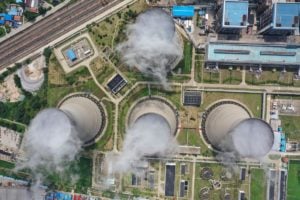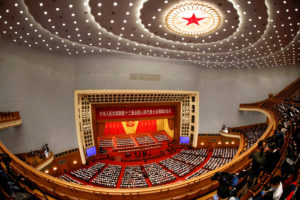In late March, the National Development and Reform Commission and the National Energy Administration jointly released the “14th Five Year Plan for a Modern Energy System”, detailing plans for China’s energy sector up to 2025.
The title is new. Since 2006, when the first Five Year Plan (FYP) for the energy sector was issued, these documents have been called “energy development plans”. The focus on a “modern energy system” reflects the particular goals for the current period – a system change that can accommodate the energy transition.
It is worth bearing in mind that the document is dated 29 January – before Russia’s invasion of Ukraine. The redrawing of energy maps that the war has brought about may not have come soon enough to have any influence. But last autumn’s coal and electricity shortages had already made energy security an obvious concern for China’s leadership. Signs of this priority were seen at the Two Sessions meetings in early March.
The plan’s opening analysis says this as a critical period for ensuring China’s energy security, with old and new risks overlapping. It judges the 14th FYP period (2021–2025) as important for laying a foundation on which China can achieve its dual carbon targets, of peaking before 2030 and neutrality before 2060. The low-carbon transition must be coordinated with supplies guaranteed, making a large-scale expansion of renewables possible, while avoiding “campaign-style” emissions cuts or indiscriminate cutting back on power consumption.
The energy transition is a pressing task, but itself brings risks of supply shortages. Reforms to the energy system are needed to avoid those risks. However, this process will not only take time, but also be somewhat reliant on fossil fuels’ swan song. That tension is evident in the plan.
Given this, the plan omits ambitious targets for renewables development, while coal and coal power are set to underwrite energy security and serve as “paving stones” for renewables. It seems the shackles on coal power may be loosening. The war in Ukraine has only made this tension more pronounced, by causing more price surges for fossil fuels.
“The Yellow River flows to the sea, but it twists and turns on its way,” said Dr Yang Fuqiang, senior advisor on the Climate Change and Energy Transition Program (CCETP) in the Institute of Energy at Peking University. The analogy expresses that while internal and external forces have pushed China to focus on stability, the energy transition will continue nonetheless.
Walking on hot coals
The new energy plan has no targets for a coal phase-out. It removes limits on total coal consumption and coal’s percentage in primary energy consumption, both of which featured in earlier FYPs. Meanwhile, the document stresses at length the importance of energy security and the role of coal and coal power in ensuring it: coal is to provide stronger energy guarantees, coal power will have a “supportive” role, and the “clean and efficient use of coal” is to be encouraged.
A State Council Standing Committee meeting in late April has since talked of “developing coal’s role as a major source of energy”. Meanwhile in early May, the People’s Bank of China increased its targeted re-lending quota for the coal industry by 100 billion yuan (US$15 billion) to support coal output and reserve capacity. Adding these developments to the weight of the energy plan, there are worries that China’s coal consumption and greenhouse gas emissions will rise in the short term, and a coal-heavy energy mix will be locked in.
The new plan has also done away with a cap on total energy consumption. This move is seen as in line with a State Council announcement that consumption of newly added renewable energy will not count towards energy consumption and intensity targets for local government – so as to allow more scope for renewables to grow. The plan also increases the target percentage for flexible power sources (to 24%) and demand-side response capacities (to cover between 3% and 5% of maximum load).
These measures should give the electricity system more of the flexibility and resilience it needs to absorb more renewable power. It also ends upper limits for coal consumption per kilowatt hour – again, interpreted as preparing the way for coal power generators to be refitted so they can provide peak regulation services for renewable power. (The rapid ramping up and down of generation to respond to peaks in demand results in more coal consumption per unit of electricity.)
Energy sector experts who China Dialogue spoke to said that the content of the plan is wide-ranging but lacks overall direction and strong quantitative targets, and sends various mixed signals. That lack of clarity, they said, arises from the government’s attempts to find a balance between ensuring short-term supply security and laying the foundation for the longer-term transition.
Fu Sha, programme director at the Energy Foundation’s Low Carbon Economic Growth Program, said the plan isn’t just about the next five years – it looks further forward to 2035. Some content is about work for the mid- to long-term transition, with a common theme of building a modern energy system that aligns with China’s dual carbon targets.
But she says the plan will allow readers to interpret it in multiple ways. For example, talk of “clean and efficient use of coal”, as well as coal liquefaction and gasification, will encourage some, while others will note the opportunities for coal power to provide peak regulation alongside renewable generation in western China. Fu also worries that the pressure for stable economic growth may lead some local governments to invest in those sectors for a short-term boost, creating unnecessary carbon emissions and plants, which will be phased out early or require expensive retrofitting with carbon capture equipment. China has already announced that coal consumption will be strictly controlled during the 14th FYP period, and fall in the following five years, and has committed to achieving peak carbon by 2030, so those investments could be in financial trouble in 10-15 years, Fu adds.
Despite those risks, Fu thinks local government officials are keeping energy consumption and intensity targets in mind. Although caps on energy consumption are being loosened from this year, and energy intensity checks are to be done every five years rather than annually to allow for more flexibility, she points out that local governments know they will still be held to account in 2025. Moreover, many energy projects still require state approval, with strict controls on energy- and emissions-intensive projects still in place. And upcoming plans for hydrogen power and energy storage, along with near- to mid-term programmes of work, will provide opportunities to respond to actual circumstances.
Fu sees a number of changes needed if the enthusiasm for coal investments is to be reined in. First, energy intensity and emissions intensity should be considered during environmental impact assessments. Secondly, the “dual control” system for energy consumption and intensity targets for local governments should transition to a new dual control system for total carbon emissions and carbon intensity relative to GDP. Thirdly, carbon markets must be expanded further. Finally, more preferential policies for renewables need to be put in place.
The ratio between gross energy consumption and gross domestic product in a calendar year. In the 11th FYP (2005–2010), China put in place its “dual controls” – targets on energy consumption and intensity – that have helped drive its energy transition and low-carbon development.
The market, too, knows it must keep one eye on the energy transition. Fu Sha says five major state-owned power firms told Energy Foundation China that renewables were their main source of profit in 2021, and that unless requested to by local government they would have little inclination to invest in coal power. Meanwhile, the People’s Bank of China has been warning financial institutions to be wary of “transition risks” arising from coal investments.
Yuan Jiahai, a professor at North China Electric Power University, also said that centrally managed state-owned enterprises don’t want to build coal power – but local governments do, to ensure supplies. He thinks strong central government constraints will be needed to prevent excessive expansion of coal power. The widely anticipated approach of turning the “dual control” system for energy consumption and intensity into one for carbon still lacks standards for calculating emissions that could be applied. Yuan thinks that, at best, the 14th FYP period will see some trials of “dual control for carbon” in a few provinces; building monitoring, measuring and statistical systems would be a good outcome, he says. But the existing dual control systems for energy will likely remain the main method of controlling emissions.
Flexible coal?
The new energy plan calls for wholesale flexibility refits for coal power generators, to help the grid absorb wind and solar power. By the end of 2025, 200 gigawatts are to be retrofitted and flexible power sources will account for around 24% of all generation – the bulk of which is bound to be coal power. According to Yuan Jiahai, some new coal power plants will be needed for peak regulation of renewables in areas of western China, as there are none nearby to retrofit. It is currently unclear how China can make sure that those new plants, built for peak regulation, are only used for that purpose, and do not start contributing to the baseload.
Yuan expects peak regulation coal power plants to run for no more than 3,000 hours a year. The current average for a coal power plant is 4,400 to 4,500 hours a year – and many still make a loss. “How are they going to make a profit on 3,000 hours?” he asks. “This isn’t just a matter of investments in stranded assets – those plants are going to be making a loss the minute they’re built.” Such a situation will spur operators to generate more power. Yuan says there needs to be a system in place to ensure the system needs those plants, and that they are properly rewarded if they are used only for peak regulation and emergency back-up. “So, the core problem for the next stage is capacity payment mechanisms for the power market.” Although the 14th FYP for energy talks of improving the market for ancillary services – those that help maintain and balance electricity transmission – Yuan says there won’t be any real progress until that is written into annual work programmes.

Dr Yang Muyi, senior electricity policy analyst at Ember, says policy pronouncements on how coal power plants should be operating are not the best approach: it would be better to use market incentives, such as creating a sound ancillary service market and capacity payment mechanism, to encourage suitable plants to provide peak regulation and back-up services for renewables. “We can see a lot of coal power plants are struggling and losing money. If peak and frequency regulation services aren’t rewarded, a transition from coal power will be more difficult.”
Shi Xunpeng, a professor at University of Technology Sydney and president of the International Society for Energy Transition Studies, thinks market reforms remain key. “At the project level, it’s hard to judge whether or not a new coal power plant makes sense, and a lot of non-market factors are influencing those decisions. For example, local governments are keen to create jobs and economic growth, and electricity generation quotas are still being awarded to coal power, so a company obtaining a quota won’t worry [about making a loss]. But if firms still want to build coal power plants after market reforms, it’s likely they are actually needed.”
Yang Fuqiang worries what long-term use of coal power for peak regulation will mean for emissions, even if there is no baseload generation. “Currently, [peak regulation with coal power] can promote growth in renewables, but over time that role should be handed over to cleaner sources. It should be temporary and transitional. But if current trends continue, it will become an obstacle.”
The main cause of last year’s power shortages was a lack of coal. Central government responded with a series of measures to increase output. In continuation of that, the 14th FYP for energy removes the limits on total coal consumption and on coal’s percentage in primary energy consumption. This has caused worries about excessive coal mining. But Yuan says the extra capacity given emergency approval last year has been brought online and any further expansion would require new coal mines to be approved – a lengthy process. So although in late April the State Council Standing Committee said there would be an additional 300 million tonnes increase in coal capacity this year, Yuan expects it will be extremely hard to achieve that.
The market will also work against increases in coal mining capacity. According to Yuan, coal mining firms want to keep output under control in order to keep prices high. They are also aware that China’s dual carbon targets puts the long-term profitability of investments in question. So “it is hard to see how extra capacity can be provided, given these restrictions.” Yuan says that while the new plan doesn’t limit coal, the fuel’s contribution to the overall energy mix will continue to fall.
Renewables: ready and waiting
While coal and coal power got plenty of attention, the new plan didn’t provide ambitious targets for wind and solar generation capacity, only saying that non-fossil energy sources should account for 39% of total power generation by 2025. The media noted that this represented a slight slowing down on the pace of change in the 13th FYP, and was less than the market had anticipated. Lauri Myllyvirta, lead analyst at the Centre for Research on Energy and Clean Air, described it as the “bare minimum” if the target of 20% non-fossil energy in total energy consumption is to be reached.
According to Yuan Jiahai, in the context of ensuring energy supplies the government should set targets in line with its Nationally Determined Contribution to the Paris Agreement: “to bring its total installed capacity of wind and solar power to over 1.2 billion kW” by 2030.
Commenting on the lack of a more ambitious five-year target, Yuan said: “Developing renewables isn’t just a matter of building generation capacity. The grid needs to be able to absorb that power. There are system issues at play. Until those are resolved we must avoid over-stimulation in the new energy sector.”
The government is also leaving itself room for manoeuvre in case it needs to respond to power shortages like those seen last year. “But in practice, it could be a case of looking relaxed from the outside, when a lot is being done out of sight.” Yuan says the government has made plans for large-scale wind farms in desert regions, and that, in practice, China will be aiming at more ambitious targets for both wind and solar.
“A lot of people say China’s taking a softer line on the energy transition. I don’t think it’s soft at all,” said Yang Muyi. He thinks the 39% target for non-fossil energy sources in power generation will mean rapid growth of wind power, for two reasons: first, hydro and nuclear power cannot be developed quickly, so growth in the coming five years will need to be from wind and solar; second, the new plan includes a target for electrification of end-use energy consumption – around 30% by the end of the period, higher than in the EU or Japan today. That, combined with the 39% non-fossil energy in power generation target, will require faster growth of non-fossil sources of power, such as wind. “Until we have a large-scale roll-out of long-duration energy storage, wind and solar alone cannot replace coal power,” he said. The plan’s emphasis on using coal power for peak regulation is intended to allow the grid to accommodate rapidly growing wind and solar generation.
It’s no longer speed of construction that will determine how fast renewables grow or the speed of the energy transition – it’s how quickly the grid can absorb those suppliesShi Xunpeng, professor at University of Technology Sydney and president of the International Society for Energy Transition Studies
Shi Xunpeng says that the lack of a specific target for wind power is in fact a positive. “In the past, targets were used to spur growth, due to their lack of competitiveness on the market. Now, wind and solar power operate without subsidies in most regions and are looking for grid access. Companies want to build, it’s the grid that’s saying no,” he said. “It’s no longer speed of construction that will determine how fast renewables grow or the speed of the energy transition – it’s how quickly the grid can absorb those supplies. Costs and technology aren’t the biggest challenges – the biggest challenge is ensuring energy security. We all saw that last year. Now’s the time for a concentrated effort to reform the electricity system, and that can’t be done in a rush.”
Yang Muyi said that the biggest contradiction now is between an old energy system and the need for development for new types of energy such as wind and solar. Failing to do so properly could lead to problems with security and stability of supply. But building new power and energy systems means changing those already in place – a complex and wide-ranging task. This is why this new plan, which aims to ensure security of supply while also building a modern energy system, seems to have no common theme, according to Yang Muyi.
Governance shortcomings need attention
“Remaking the energy system isn’t just about energy markets,” said Yang Muyi. “Governance needs to be remade too.”
When reviewing provincial coal power approvals for 2020, Greenpeace found contradictory reasons given by those in east and west China. In the west, new coal power plants were said to be needed so power could be exported to the east, while in the east, they were justified on grounds of self-sufficiency. The new plan also calls for increasing both “clean energy bases” in the west, which means mainly solar and wind coupled with coal power, and “non-fossil” energy in central and eastern China, which may include hydro and nuclear. But wind and solar, while non-fossil energy sources, need support from fossil fuel power for peak regulation, and long-distance transmission lines take a long time to build. In the end, we may see new coal power plants built both in the east and west of the country, to prevent power shortages like those seen last autumn.
It’s time to remake the entire system. There can’t be any weak points. If there are, we won’t be able to make progressDr Yang Muyi, senior electricity policy analyst at Ember
Yang Muyi thinks power governance in China lacks cross-regional coordination, meaning resources aren’t allocated as efficiently as they could be. He points out that eastern provinces don’t control the power plants they rely on for imported electricity, and they cannot guarantee such projects will be built on time, or that the exporting provinces won’t hold back electricity for their own use. The importing provinces therefore build their own power plants to ensure supplies, duplicating those already built elsewhere.
That, he says, is why coordination across provinces is so vital. A paper that Yang and Shi Xunpeng co-authored suggested looking at a coordination mechanism for the entire Guangdong-Hong Kong-Macau Greater Bay Area. In that paper they pointed out that China’s energy governance works top-down – targets are set, plans are drawn up accordingly, and instructions passed down through the layers of government. That has advantages when it comes to mobilising resources and driving economic growth. But it means local governments have limited policy tools and powers, and are unable to coordinate with other jurisdictions when needed, either across or within provinces. For example, local governments are unable to arrange for other jurisdictions to provide peak regulation for their renewables generation as they phase out coal. Coordination across wider areas is needed.
The new energy plan proposes an implementation mechanism, coordinated by the National Energy Commission, managed by government departments, and with provincial governments and major energy firms doing detailed implementation work. But Yang Muyi warns that in China, coordination happens during planning and target-setting, and only rarely during implementation. Shi Xunpeng said that cross-regional coordination on grid operations needs to happen on a monthly, daily and even hourly basis. But coordination by the National Energy Commission happens only when systems are being put in place or plans implemented.
“It’s time to remake the entire system. There can’t be any weak points. If there are, we won’t be able to make progress,” said Yang. He added that the core issue is this: what is it most efficient for the market to do, and what is best left to government? Both will have their roles to play – the question is how to balance them.








